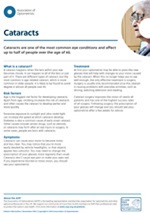Cataracts
Cataracts are one of the most common eye conditions and affect up to half of people over 60
What is a cataract?
A cataract happens when the lens within your eye becomes cloudy. It can happen to all of the lens or just part of it. There are different types of cataract, but the most common is age-related cataract, which is more common in people over 65. It can be found to some degree in almost all older people.
Risk factors
Age is the biggest risk factor for developing cataracts. Apart from age, smoking increases the risk of cataracts and often causes the cataract to develop earlier and more quickly. Excessive exposure to sunlight and ultraviolet light can increase the speed at which cataracts develop. Diabetes is also a common cause of early onset cataract. Other causes include certain drugs, such as steroids, or cataracts may form after an eye injury or surgery. In some cases, people are born with cataracts.
Symptoms
Cataracts can cause your vision to become misty and less clear. You may notice that you’re more easily dazzled by vehicle headlights, or that objects appear less colourful. You may need to change the prescription of your glasses more regularly than usual. Cataracts don’t cause eye pain or make your eyes red. If you experience blurred or misty vision, you should see your optometrist.
Treatment
At first your optometrist may be able to prescribe new glasses that will help with changes to your vision caused by the cataract. When this no longer helps you to see well enough, the only effective treatment is surgery. Surgery is usually only recommended once the cataract is causing problems with everyday activities, such as driving, watching television and reading.
Cataract surgery improves the vision of nearly all patients and has one of the highest success rates of all surgery. Following surgery, the prescription of your glasses will change and you should see your optometrist after a few weeks for advice.
Resources for your practice

You can download our patient leaflet on cataracts.
If you're a practitioner, we recommend that you use this information, following a suitable examination to reinforce advice given to the patient who has presented with symptoms of cataracts.
Visit our For patients section for more info on eye health.

